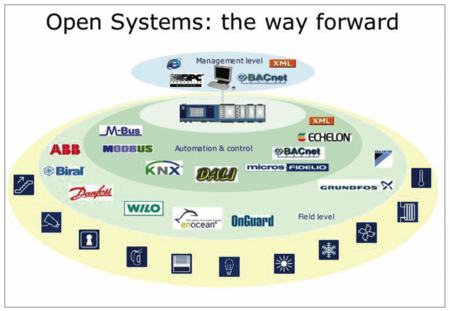Open systems — the way forward
Anders Norén explains how using a number of open protocols to bring together a host of building services is the key to interoperability.Interoperability in a typical commercial office building means bringing together a host of building services and their diverse range of communication systems. Here are some examples. • BACnet over RS485 or IP is supported by most HVAC control systems. • Meters, chillers and inverters commonly use Modbus in the UK. • M-bus is also used in the metering of utilities. • Two protocols used in lighting are EIB/KNX and DALI. • Moving on to the management and interpretation of data, XML is used for the exchange of data between web-based applications and devices. • LonWorks typically serves HVAC, lighting and process devices on a network. • OPC server and OPC client enables PC-to-PC applications. • TCP/IP is used to transmit data across communications networks, such as an organisation’s IT network or the Internet. Currently, the end-user (facilities manager, financial director etc.) is offered front-end solutions that, in combination with intelligent outstations, manage and control the connected building services at management level. These front-end solutions are normally web-based and provide the end-user with communication and access to the various building services from many locations using nothing more than a web browser. Communication between the web-based solution and the system itself is based on OPC, BACnet, XML or proprietary systems. The network connections are achieved using the building’s IT network via TCP/IP or the traditional building management system (BMS) network wiring (i.e. RS485 over a single twisted network cable). To such a network, the industry can add and combine different third-party sub-systems (metering, security, fire alarm etc.) that, together with the HVAC main plant, will result in an integrated BMS automation and control. These sub-systems are accessed from a common front-end and can be built up using products from various suppliers employing the communications protocols as mentioned above. The communications network may comprise RS485, LonWorks or TCP/IP, or a combination thereof. Open-system examples Here are three examples that clearly demonstrate the advantages of open systems. Metering: Traditionally, meters have been read manually or connected to the BMS by counting pulses. A much more cost effective solution is to network the meters using Modbus or M-bus.
From a web browser at management level, a variety of protocols are widely used to connect the wide range of equipment that services a modern building — and no single one is likely to become the de facto standard.








